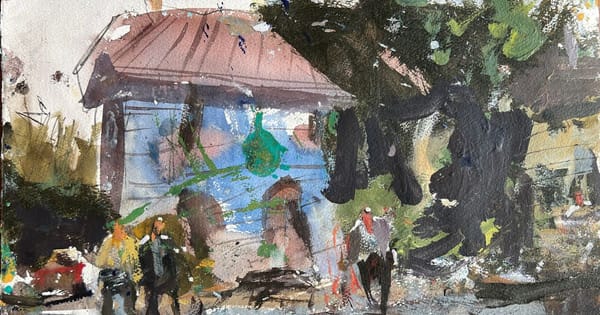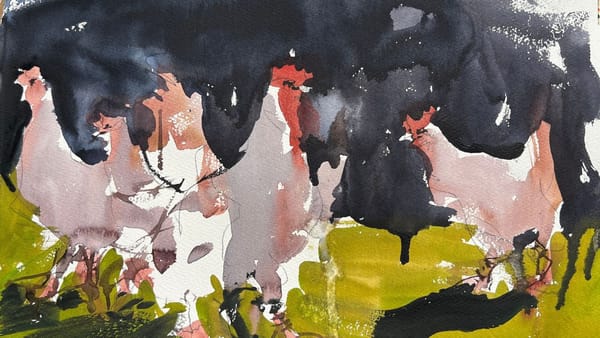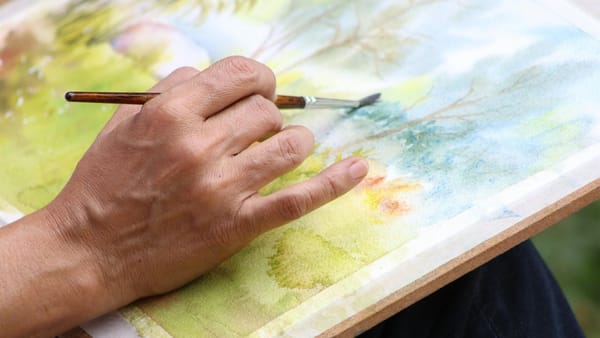Watercolor Tips For Capturing Harbor and Boats
Get watercolor painting tips and techniques for capturing harbors and boats in a shorter, more concise answer. Easy to follow advanced tutorial.
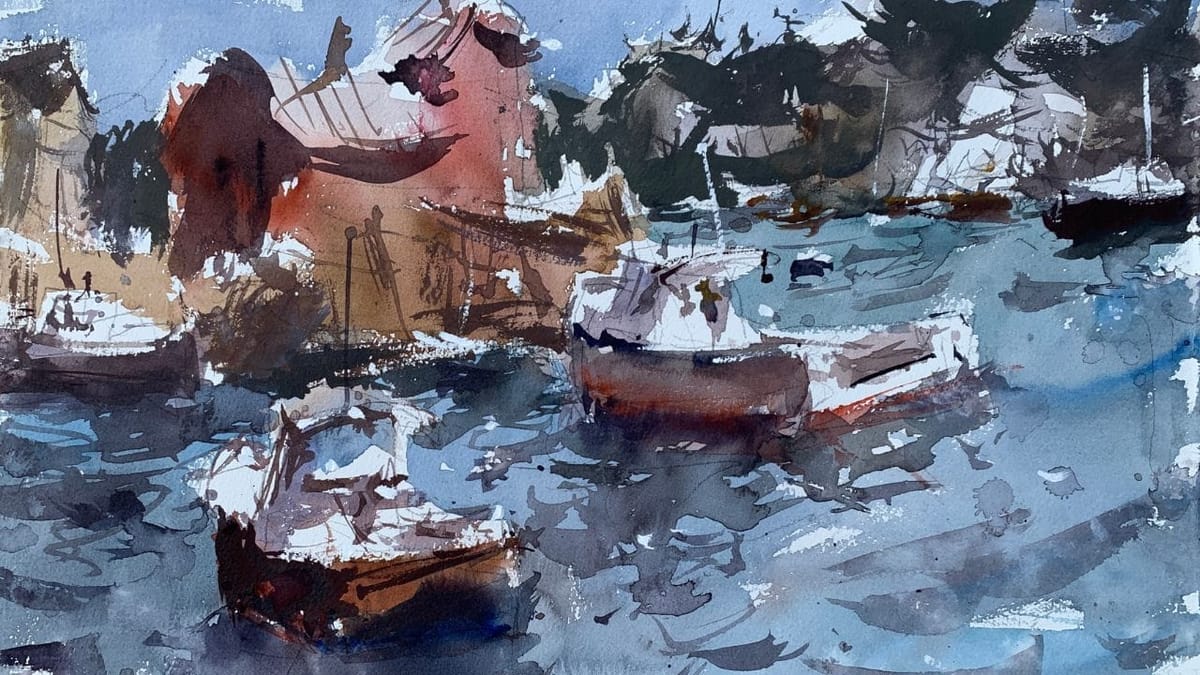
Whether you are a seasoned watercolorist or a beginner, this lesson will provide you with valuable tips and techniques to bring your harbor and boat paintings to life. Spoiler alert, I’m a fan of work boats, not yachts. Maybe it’s the middle class upbringing and lack of zeros in my savings account. But hear me out, you can apply these watercolor landscape painting ideas to all types of floating vessels.
Let’s crack into some tips for painting boats and harbors with watercolors
Watercolor is an ideal medium to use for painting maritime scenes. We will kick things off with a video demo where I paint a loose, expressive harbor scene that I hope will inspire your next masterpiece. So, grab your brushes and let’s set sail on a nautical painting adventure!
Video tutorial
Study and Observe
Before diving into your painting, take some time to observe the harbor and boats you wish to capture. Visit the location, if possible, and immerse yourself in the atmosphere. Observe the play of light on the water, the reflections, the colors of the boats, and the overall composition. Take photographs or make sketches to reference later. Understanding the subject matter will enable you to add authenticity and depth to your paintings.
Presented below is the inspiration image for my painting, brimming with an insane amount of details that possess the potential to overwhelm the composition. Remember, it is crucial to initially focus on the prominent shapes and assess their compatibility with the overall design.
Should the design and composition fail to harmonize, the entire artwork may suffer as a result. So, spend time learning how to use good design techniques and avoid common mistakes such as symmetry, tangents and cropping errors.
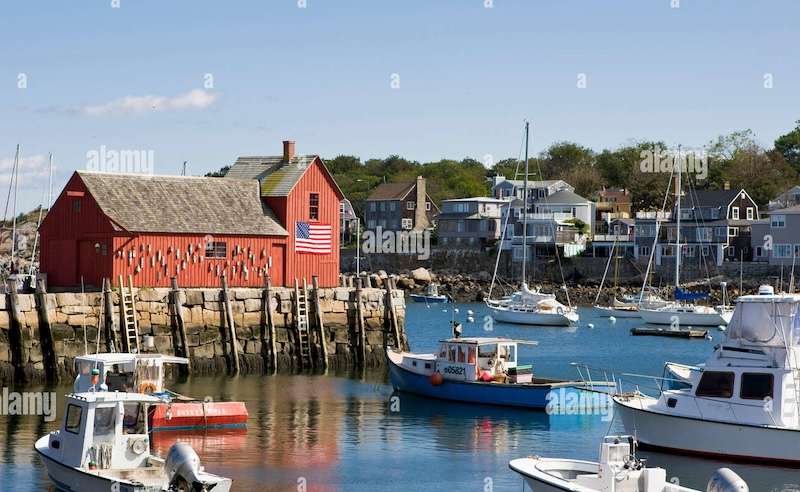
Start with a Plan
Before applying the first brushstroke, create a rough sketch or thumbnail of your composition. This will help you establish the overall layout and balance of your painting. Consider the placement of the horizon line, boats, and any architectural elements, such as piers or lighthouses. Keep in mind the rule of thirds or other compositional techniques to create a visually pleasing arrangement.
Colors and Palettes
Harbors and boats offer a vibrant color palette that can be both challenging and exciting to work with. Choose a limited range of colors to maintain harmony and balance in your painting. Blues, greens, ochres, and warm grays are commonly found in harbor scenes. Experiment with different color combinations to create depth and capture the unique atmosphere of the location. Remember that watercolor paints tend to dry lighter than they appear when wet, so test your colors on a scrap paper before applying them to your artwork.
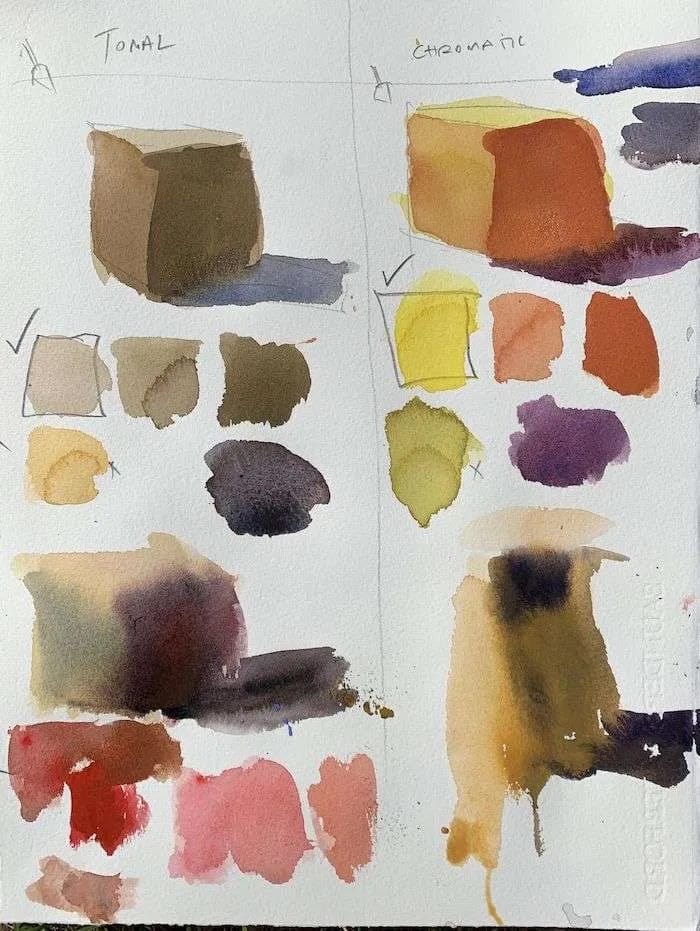
Mastering Water and Reflections
Water is a crucial element in harbor scenes, and capturing its translucency and reflections is essential. Begin by wetting the area where the water will be painted, then introduce colors in a loose and fluid manner. Use horizontal brushstrokes to mimic the movement of water. To create reflections, simply mirror the shapes and colors of boats or buildings, with a slight softening effect. Remember that reflections are often darker and less detailed than the objects being reflected.
Boats: Focus on the Big Shape
Boats are the heart of any harbor scene, and paying attention to their shapes will elevate your painting. Start by sketching the basic shape of each boat, focusing on proportions and perspective. Try looking at the contour before adding details.
Add small details like masts, ropes, and windows to create interest. Use different brush sizes and techniques to achieve texture and depth. Be patient and take your time, as capturing the intricate details of boats can be challenging but rewarding.
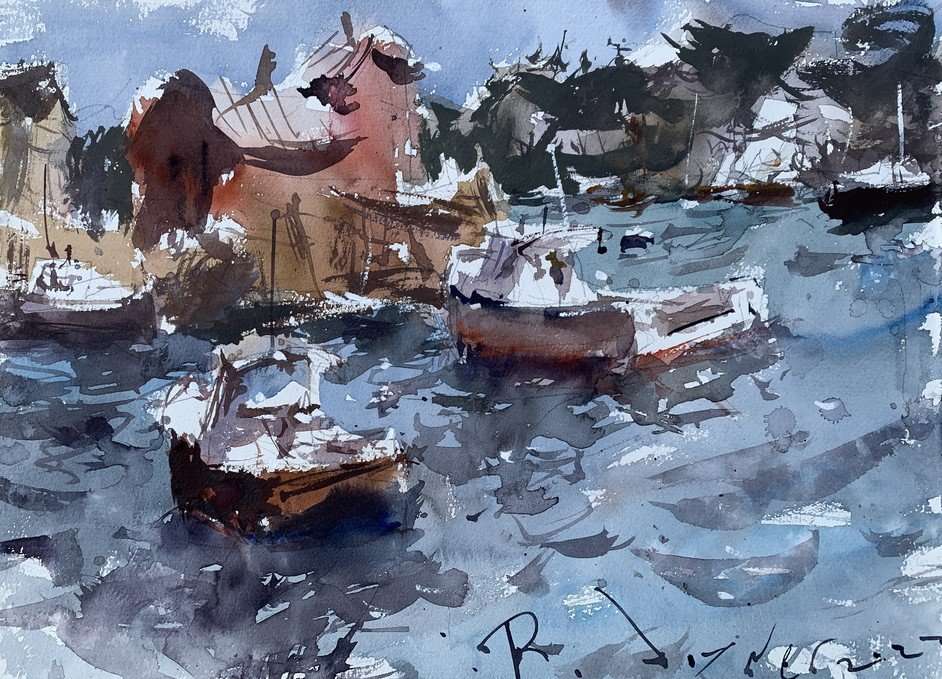
Play with Light and Shadow
Light and shadow add drama and dimension to any painting. In harbor scenes, the interplay of light and shadow can be particularly captivating. Observe the direction of light and its effect on the boats and surrounding structures. Use light washes for the sunlit areas and darker washes for the shadows. Enhance the contrast to create a sense of depth and three-dimensionality.
Add People and Activity
Including figures and activity in your harbor painting can bring it to life. Paint tiny figures on boats or along the harbor, capturing the sense of movement and the scale of the scene. Suggest activity through small details like flags, seagulls, or waves. These elements not only enhance the narrative of your painting but also add a sense of scale and proportion.
Suggested Material Checklist
Materials can make or break the outcome of a watercolor study. Watch the video that covers the best watercolor materials if you need more specifics about color choices, brush sizes and such. Basically, it’s exactly what I use and recommend for all levels.
Watercolor Paints: Opt for artist-grade watercolor paints in a range of colors. Choose a basic palette that includes six primary colors (one cool and warm hue for each one including red, blue, and yellow) along with earth tones for a versatile collection.
If you aren’t aware of the six primary palette, then check out our in-depth article on how to mix watercolors for beginners. It has the exact hues I use for every painting. And, if I make changes, I always update the article so you know the exact hues that get the best results.
Brushes: Invest in a set of good-quality watercolor brushes with different shapes and sizes. Round brushes are excellent for detailed work, while flat brushes are great for larger washes. I’d recommend one medium and one large pointed round. Then get a large mop brush that will handle those initial washed that are applied in the very beginning.
You only need three brushes to do most of the heavy lifting! However, I do recommend having a dagger and possibly and Motler on hand as well. Check out the article I wrote on how to choose the best watercolor brushes if you have questions on the exact brands, sizes and such.
Paper: I highly recommend selecting watercolor paper specifically designed for this medium. Look for papers labeled “cold-pressed” or “hot-pressed” to suit your preferred texture. Experiment with different weights and brands to find the one that suits your style. Most beginners choose 140 lb. cold press to start their journey. Hot press tends to be a little slick and most used for highly detailed work and portraits.
Avoid cheap, wood pulp papers as they don’t react properly to washes and other techniques. These cheaper papers tend to break down quickly and don’t age well either, basically yellowing over time. Be sure to read the how to choose the best watercolor paper article when you have time.
If you aren’t aware of the six primary palette, then check out our in-depth article on how to mix watercolors for beginners. It has the exact hues I use for every painting. And, if I make changes, I always update the article so you know the exact hues that get the best results.
Palette: A palette is essential for mixing and diluting your watercolors. Choose a palette with wells to hold different colors and a large mixing area. Small palettes tend to get dirty too quick and I found it difficult to have enough free space to mix enough colors without having to stop everything to clean up. The Masterson Pro palette works great and available at Amazon and Blick Art.
Water Containers: Have at least two containers for water—one for rinsing your brushes and another for clean water. Make sure the containers aren’t too small, and I would recommend plastic over glass. I’ve had plenty of studio accidents and cleaning up shattered glass isn’t ideal when in a creative mode.
Masking Tape and Drawing Board: Masking tape helps secure your paper to a drawing board, keeping it flat and preventing it from warping. The tape is optional and depends if you prefer the clean edges. In the beginning you will most likely focus on sketches and studies, so maybe pass until you determine later on if you need it.
A smooth, firm board is a must! I recommend Gator foam board as it’s very sturdy, smooth and durable. Fairly inexpensive and light weight to boot. That covers materials, let’s move on to skills you need to start watercolor painting.
Conclusion
Watercolor is a versatile medium that allows artists to capture the vibrant beauty of harbors and boats with its fluidity and transparency. By studying and observing your subject, planning your composition, selecting a harmonious color palette, mastering water and reflections, focusing on boat details, playing with light and shadow, and adding people and activity, you can create captivating harbor and boat paintings.
Remember, practice makes perfect. Embrace the process of learning and experimenting with different techniques. Each painting you create will bring you closer to mastering the art of capturing the essence of harbors and boats in watercolor.
Additionally, don’t be afraid to add your personal touch and style to your paintings. Whether you prefer a realistic approach or a more loose and impressionistic style, infusing your work with your unique artistic voice will make it truly special.
Lastly, enjoy the journey. Painting harbors and boats allows you to explore the serenity of the sea, the charm of coastal towns, and the fascinating world of maritime activities. Let the process of creating art take you on a nautical adventure, filled with creativity, inspiration, and a deep appreciation for the beauty of harbors and boats.
So, set sail with your watercolor palette, immerse yourself in the beauty of the sea, and let your brushes dance on the paper as you create stunning harbor and boat paintings that capture the essence of these maritime scenes. Happy painting!
